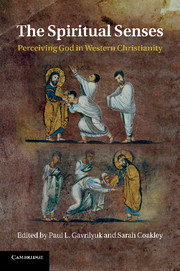Book contents
- Frontmatter
- Contents
- Contributors
- Foreword
- Abbreviations
- Introduction
- Chapter 1 Origen of Alexandria
- Chapter 2 Gregory of Nyssa
- Chapter 3 Augustine
- Chapter 4 Gregory the Great
- Chapter 5 Pseudo-Dionysius the Areopagite
- Chapter 6 Maximus the Confessor
- Chapter 7 Alexander of Hales
- Chapter 8 Thomas Gallus
- Chapter 9 Bonaventure
- Chapter 10 Thomas Aquinas
- Chapter 11 Late medieval mystics
- Chapter 12 Nicholas of Cusa
- Chapter 13 Jonathan Edwards and his Puritan predecessors
- Chapter 14 John Wesley
- Chapter 15 Karl Rahner and Hans Urs von Balthasar
- Chapter 16 Analytic philosophers of religion
- Select bibliography
- General index
- Index of select biblical references
- References
Introduction
Published online by Cambridge University Press: 05 December 2011
- Frontmatter
- Contents
- Contributors
- Foreword
- Abbreviations
- Introduction
- Chapter 1 Origen of Alexandria
- Chapter 2 Gregory of Nyssa
- Chapter 3 Augustine
- Chapter 4 Gregory the Great
- Chapter 5 Pseudo-Dionysius the Areopagite
- Chapter 6 Maximus the Confessor
- Chapter 7 Alexander of Hales
- Chapter 8 Thomas Gallus
- Chapter 9 Bonaventure
- Chapter 10 Thomas Aquinas
- Chapter 11 Late medieval mystics
- Chapter 12 Nicholas of Cusa
- Chapter 13 Jonathan Edwards and his Puritan predecessors
- Chapter 14 John Wesley
- Chapter 15 Karl Rahner and Hans Urs von Balthasar
- Chapter 16 Analytic philosophers of religion
- Select bibliography
- General index
- Index of select biblical references
- References
Summary
When a man's senses are perfectly united to God, then what God has said is somehow mysteriously clarified. But where there is no union of this kind, then it is extremely difficult to speak about God.
Christian authors of all ages have used sensory language to express human encounters with the divine. In the Old Testament believers are enjoined to ‘taste and see that the Lord is good’ (Ps 34[33]: 9, 1 Pet 2: 3); the prophets and others ‘hear the word of the Lord’ (Isa 1: 10; Hos 4: 1); the beatitude promises that ‘the pure in heart will see God’ (Mt 5: 8); the apostle Paul speaks of receiving the vision of God ‘face to face’ (1 Cor 13: 12) and beholding ‘the glory of the Lord as in a mirror’ (2 Cor 2: 18); the faithful are said to inhale the ‘sweet aroma of Christ’ (2 Cor 2: 15); and the witnesses of the incarnation speak of ‘touching with [their] own hands’ the Word of Life (1 Jn 1: 1). These biblical passages seem to point to certain features of human cognition that make perception-like contact with God possible. But how precisely should these statements be construed? What implications do these claims have for theological anthropology? Do such statements imply peculiar modes of seeing, hearing, smelling, tasting, and touching divine things?
As might be expected, the claim to have a special form of perception that makes direct human contact with God possible is both epistemologically and metaphysically problematic. While there is a general agreement that humans possess the five physical senses, there is no comparable consensus regarding other modes of perception. Moreover, the claim that God could be perceived by special senses seems to violate notions of divine transcendence and immateriality. After all, when attempting to look at God, one is ‘looking at what cannot be seen’ (cf. 2 Cor 4: 18, Heb 11: 27). As the creator, God is ontologically different from all ordinary objects of perception.
- Type
- Chapter
- Information
- The Spiritual SensesPerceiving God in Western Christianity, pp. 1 - 19Publisher: Cambridge University PressPrint publication year: 2011
References
- 1
- Cited by



